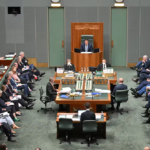Sport and innovation drive Australia forward

I’ve been asked to provide an Australian perspective on innovation. So let me begin in the most Australian way possible: with a story about sport.
And it’s a story in honour of the great Sir Roger Bannister, who passed away last month. The year is 1954. No human being, in all recorded history, had ever run a mile in under four minutes. It was the Mount Everest of sport, the barrier they said could never be conquered.
A young Briton named Roger Bannister nailed it in Oxford on May 6: but with the assistance of a series of runners who were pacing him. A young Australian named John Landy absolutely smashed it, in Finland, on June 21: this time, unaided.
Now they were heading to Vancouver, to the 1954 Commonwealth Games, to go head to head for the gold. The gun was fired. 100 million people listening on the radio held their collective breath. They were off…
John Landy races to the lead…
And as we all know, he won – unless you count that final stretch of the race, when he turned his head just enough to see where Bannister was placed, and in that last desperate sprint down the home strait…
Well, yes. Roger Bannister passed him. So technically, you could say that Bannister won.
But I told you this piece would be an Australian perspective on innovation. And as an Australian, I say, for our purposes, they both won. Sport won. We all won! Because both athletes did the impossible. They cracked the four minute mile. And the world looked on, and cheered.
Why tell that story? Because I can’t talk about the cricket. My apologies. I have two reasons.
Reason One: Because it’s really a story about scientists.
It’s true: these two Miracle Milers were scientists first, and athletes in their spare time. Roger Bannister was a medical student who became a neurologist. In 1954 he published one of his first academic papers: on the impact of oxygen on athletic performance.
John Landy was an agricultural science student who became a research manager and natural historian.
He got his start in science chasing butterflies. If you think it’s great to float like a butterfly, try running like a butterfly hunter. Up a mountain. In the outback. With a net. You couldn’t help but get fit.
So, to all the girls and boys in the Commonwealth, sitting in school today, and dreaming of butterflies: dream also of the winners’ podium at some distant Commonwealth Games, but stick to your science!
Reason Two: this is not just a story about scientists. It’s a story about how difficult things get done. And so it’s a story about innovation.
Think of the things we believed about human capability as late as 1950. Doctors and athletes said it was impossible to run a four-minute mile: literally impossible. Not just a psychological barrier, but a biological limit. The human body would break.
The record stands today at 3 minutes and 43 seconds.
And it’s not because humans are born with more natural talent. I’m not here to debate the science of evolution – but trust me, Millennials are not a different species. Humans haven’t evolved into a biologically different animal in the space of sixty years.
No: athletes run faster today because people like Roger Bannister and John Landy worked out how, relentlessly. And in their story I see all the key elements of innovation strategy writ large.
The 2030 Plan for Australian Prosperity
In Australia, we crystallised those elements in the 2030 Plan for Australian Prosperity.
It was developed by a body established by the Prime Minister Malcolm Turnbull, called Innovation and Science Australia. As Chief Scientist, I serve as the Deputy Chair.
But we built that strategy for Australia with the benefit of insights from many countries, including the countries represented here today. So with that lens, here’s how I read the Bannister and Landy story.
The four elements of success
It starts with aspiration. Like all elite athletes, Bannister and Landy wanted to win. Not just at the club level. Not just at the national level. At the international level. They wanted to stand on the podium at the Commonwealth Games with a faster time than any human being in history had ever run. And so they fought for every fraction of a fraction of a second.
They ran through sickness, and in Landy’s case, through injury. He stepped on broken glass in the days before the big race in Vancouver. They stitched him up and then he got on with the job. You need that fire and determination to be globally competitive – not just good, the best.
But aspiration is not enough. The next essential ingredient is education. Great athletes seek out great coaches. They know that talent doesn’t trump technique. Whatever your natural advantages, you have to start young, listen up and knuckle down.
John Landy in particular was well ahead of his time. He studied many different training regimes under several great coaches. With their help, he worked out a lot of the best practice principles that elite runners swear by today – just six decades early. People still study his training program, it was that good.
But Landy would tell them they have to do more than study it.
They have to push beyond it: and for that, you need science and technology. The third essential element. I think about sport like an engineer. It’s just physics and biology. Everything else is marketing.
The key is the efficient conversion of energy to output. Training helps you to calibrate the machine. But science and technology help you to change the equation.
For example: running shoes. In Ancient Greece, you ran barefoot. Then athletes started showing up in leather sandals, and those athletes would win. Lesson learnt: humans run faster in shoes. The Romans added spikes. Of course, the Romans added spikes.
Then came the Dark Ages and nothing much happened in sport shoe innovation for the next 18 centuries. In the nineteenth century, we got runners made out of rubber and canvas. In the 1930s, we got cushions and side supports. In the 1970s, we got Nike Air.
And Nike got the air from NASA. A NASA engineer was working on lightweight space helmets when he came up with the idea of using similar techniques to put a pad of interconnected air cells into running shoes. Nike was sold.
Today, we’ve got customised 3D-printed spike plates, polymer soles and nano-mesh uppers. The point is that we would still be running in leather sandals if not for the scientists who invented new materials, and the engineers who turned them into shoes.
The final element, after Aspiration, and Education, and Science and Technology, is data. Data to scrutinise your performance. Data to make yourself accountable. And data to work out how to improve.
It wouldn’t be sport without statistics. To the fans it might be trivia, but to the athletes it’s pure gold.
Learning from Montreal ’76
Now Australians know that we can bring all these elements together in sport. That’s why we get so angry when we lose: the ingoing assumption is that we ought to win. When we came home from the Montreal Olympics in 1976 without a single gold medal, it was a national crisis. We stopped kidding ourselves that talent and a bit of grit was all it takes.
It wasn’t enough: not when our competitors were approaching sport as a national priority. We set out to beat them fair and square. We said we could do it, and so we did.
We rolled out the Life Be In It Campaign: lesson from the Soviets, mass participation in sport! We put funding into sports facilities and scholarships: lesson from the Americans, invest in elite education.
We built high-performance programs combining excellence in science with excellence in coaching: lesson from industry, project management.
We hit a gold streak. And then we hit a second gold streak: selling our winning strategies to our competitors. That’s sport: you’ve got to keep raising your game. You can look at the global rankings today: out of all the sports science programs in the world’s universities, 10 of the top 50 are found in Australia. Two are right here in Queensland.
So from our Montreal moment in sport, we learned, and we acted.
Innovation in the economy
If we can do it in sport, then we ought to be able to do it across the economy. The challenge is to do it without a Montreal moment, in our twenty-seventh year of continuous economic growth.
Australians like to say that we’ve been lucky. But where we’ve succeeded, we’ve also been smart.
Look at mining: we are home to the most advanced mine sites in the world. Yes, we’re lucky to have rocks in the ground, but we’re smart to get them out of the ground with self-driving trucks and remotely controlled drills.
It’s innovation: you just don’t see it if your definition of innovation is limited to start-ups in big cities.
For a truly high-performing economy, we need to think differently: to recognise innovation in all its forms, and to push for it in every industrial sector, including traditional ones.
Let me give you two examples from Queensland.
Every Australian knows the Queensland slogan: beautiful one day, perfect the next. This is a State with a reputation for making good things even better. So here are two things you think could never be made any better in Queensland: One, bananas. And two, sunshine.
Bananas
This story comes from the Queensland University of Technology. In developing countries like Uganda, Vitamin A deficiency is a serious problem. Around the world, up to half a million children go blind, every year, through a lack of vitamin A.
A staple part of the diet in Uganda is the East African Highland cooking banana. It’s high in starch, but very low in Vitamin A. So Queensland researchers, with the support of the Bill and Melinda Gates Foundation, saw a golden opportunity: to boost the banana.
They took the big yellow Cavendish bananas that we love so much in Australia, and inserted a gene from a Melanesian variety that is naturally high in pro-vitamin A but only grows in small bunches.
Bingo: a high-yield, vitamin A rich banana now in field trials in Australia and Uganda, with the added bonus of knowledge transfer, thanks to the Ugandan students who came out to Australia to be part of the project and take back the technology.
Great produce is a luxury that Australians take for granted. But agricultural technology is literally a way of harvesting our ideas. We have learned to farm in almost every sort of climate that Nature can throw at us. And we can sell that expertise to the world, just as we sell our value-added livestock and crops.
That’s innovation – doing things differently and doing them better
Sunshine
Take sunshine. Queensland has a lot of it. So what to do with it? Make energy.
One exciting project takes a disused gold mine up in the north. The plan by Genex Power is to build an integrated solar and pumped hydro energy hub. The solar farm will generate the energy to pump the water from the cavity at the bottom of the abandoned mine to the reservoir at the top. And when required, the water can be released, to power the turbine and generate electricity.
It’s the new goldmine: solar backed up with storage. We’ve had our challenges in Australia with the transition of the electricity network. That’s no secret. But Queensland has flagged its ambitions to compete in the global market for twenty-first century solutions.
I think of the new Electric Super Highway, lined with charging stations that will take you 2,000 kilometres, from the Gold Coast to Cairns, in an electric car.
Those charging stations are home-grown: Queensland technology, from a Brisbane-based company named Tritium. And you won’t just find Tritium charging stations in Queensland – they line the highways in the United States and Europe as well.
Won’t it be wonderful when Queensland’s Super Highway is a Solar Super Highway, running on twenty-first century Queensland gold? Again – doing things differently and doing them better.
The future of innovation
Just as Queensland has captured its golden resources, the Board of Innovation and Science Australia has bottled the essence of Australian innovation into that 2030 Plan for Australian Prosperity.
Its five imperatives across education, business, research, government and culture map to all the breakthrough innovations I’ve mentioned. Learning never ceases. Innovation is a way of life. In Australia, across the Commonwealth, throughout the ambitious nations of the world.
So here’s to the Miracle Milers, Sir Roger Bannister and John Landy. And the last word to Sir Roger, the athlete who always won in the final moments of the race. “No one can say “you must not run faster than this” or “you must not jump higher than that”. The human spirit is indomitable.”
To which I say, hear hear.

Alan Finkel is Australia’s Chief Scientist. A neuroscientist, engineer, entrepreneur and philanthropist, he served as Chancellor of Monash University in 2008-2016.











